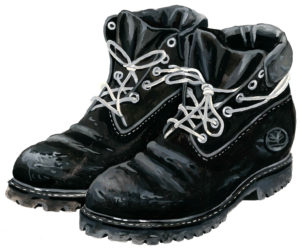
Early one autumn morning, as I raced out of my building and down the street to catch the train, I found myself slowed by a glut of pedestrians headed the same way. As I scanned the crowd for possible beeline options, I spied a tall woman with long, spiraling locs spilling down her back, clad in a slightly rumpled, straight-cut, olive green knee-length jacket. Beneath, she wore milk chocolate brown slacks and a pair of nondescript, sensible black shoes. She carried a worn, cognac leather satchel on her arm, and fluttering slightly in the wind as she walked, a richly pumpkin-hued shawl-as-scarf around her neck.
As a woman long intrigued by clothing, I appreciated the color palette and breezy approach to layering. As a woman that actually has to wear clothes on a daily basis, I was drawn to the practically palpable comfort and ease she exuded—a far cry from the frenzied feeling that accompanies the increasingly hyperbolic headlines that have come to characterize a vast swath of fashion writing. “27 Sparkly Ankle Boots For the Season Ahead.” “How to Get Your Hands On the Must-Have Meghan Markle-esque White Wrap Coat.” “19 Yellow Sweatshirts To Brighten Your Closet and Your Life.”
I’m paraphrasing here, but not much.
Fashion has always occupied a wobbly, liminal space between utility and frivolity. That is, clothing protects us from the elements, and, for the most part, we’re all expected to dress ourselves before interacting with the rest of society. But while you’re at it… why not wear a beret instead of a beanie this winter? They’re all the rage this season. Like a cross between a carnival barker and snake oil salesman, each fawning sales-pitch-turned-trend-write-up inflates the potential benefits of retail therapy far beyond reason. If you simply acquire the right object, all will be right with the world, each headline’s subtext screams. That is, until the next sartorial balm comes along.
Of course, I’m hardly immune to the siren song of retail therapy as touted by magazines and/or a well-placed sale. I can even attest that, under the right circumstances, it provides a potent, though short-lived, mood boost. Still, by definition, it’s not sustainable — financially or environmentally. In a fashion landscape populated by unattainably expensive garments that function as status symbols and wear-it-now, toss-it-tomorrow “fast fashion” pieces meant to capture a fleeting trend before it disappears, I’m trying to find inspiration in the gap between the two: my own closet.
As Rihanna so brilliantly put it, “I have had the pleasure of a fluctuating body type,” and because I never quite know which garments will fit on any given morning, it’s all too easy to end up rushed, flustered, and frustrated at the exact moment I need to be on my way out the door feeling confident and put-together. These days, I’m trying to ignore that nagging feeling that I’d feel, look, and be better if I just found the right thing to buy. Instead, I’m working on recovering the aesthetic potential of the pieces I already own: dress therapy instead of retail therapy.
It’s a mission easier said than done, but it helps to remember my 14 years spent wearing a Catholic school uniform. Back then, dress down days were a rare thrill, and I treated each one as an shining opportunity to create a feeling and convey some kind of message, even if no one besides me could decipher it. I can recall being smitten with horizontally striped ribbed knit tops and polyester blend bottoms one year, as I believed they telegraphed a certain kicky-casual sportif energy that I wanted to embody. Another year, I insisted on patched and otherwise embellished denim, craving a sort of countercultural appeal way beyond my years.
Even when wearing my uniform, I found ways to infuse each piece with personality, the day’s mood. A taut knee sock at the end of a school day was the mark of a plucky go-getter type. An untucked blouse, though grounds for an infraction, was a sure way to advertise an approachable informality.
Perhaps the messages I was conveying weren’t indecipherable so much as fluid and fitful: Here I am, the I in question changing a bit every year, every month, every day. In any case, I used to approach getting dressed each day as if it were a celebration of that I. Surely there’s much to be gained by recapturing the joy of that daily ritual.
I woke up this morning to several inches of snow and thoughts of my trusty black Timberland boots, purchased in high school and worn to shreds over 10 years before immediately replacing them. Growing up in New York, they always represented a regional ruggedness to me. Dreading the prospect of trudging out in the cold, I decided to start with Timbs and work my way up.
It was the kind of day when I didn’t want much from my outfit aside from warmth and extreme comfort. Still, the process of acknowledging that desire and achieving it, no matter how simple the look that resulted from it, was its own sort of pleasure. I didn’t grapple with what a comfy outfit ought to look like for someone with my particular hip measurements; I didn’t need to figure out what cozy looks like this season through the lens of Fashion.
From here on out, I can just arrange my garments in a way that simply—or intricately!—works. For me.


Grok Nation Comment Policy
We welcome thoughtful, grokky comments—keep your negativity and spam to yourself. Please read our Comment Policy before commenting.